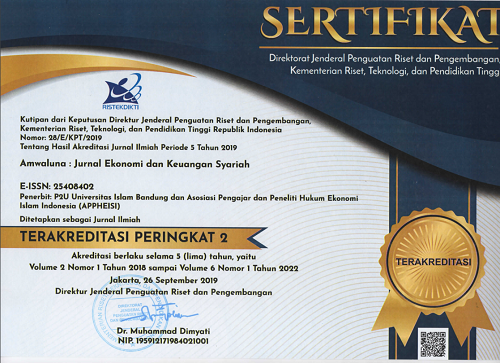ANALISIS PELUANG DAN TANTANGAN LEMBAGA KEUANGAN SYARIAH UNTUK MENINGKATKAN DAYA SAING MENGHADAPI MASYARAKAT EKONOMI ASEAN
Abstract
Indonesia has a big potential in the development economic of sharia, it has a large number of Muslim population and abundant natural resources that can be used as an underlying transaction in sharia economy. But lots of obstacles has been faced by Indonesia while developing its sharia economy so that they have low competitiveness compared with conventional financial institutions and sharia financial institutions from other ASEAN countries, especially Malaysia. Obstacles that were mentioned are the lack of human resources sharia economy in both quantity and quality, the lack of knowledge and awareness in economic sharia, the lack of innovation and product differentiation, and lack of support from either government regulation or the issuance of capital. It is necessary to provide efforts and strategies to improve the sharia economic competitiveness in order to win the competition at the ASEAN Economic Community (AEC). Efforts and strategies may include the improvement of human resources in both quality and quantity, socialization and education in the community, service improvement and product differentiation, and the support from all of the stakeholders.
Keywords
Full Text:
PDF (Bahasa Indonesia)References
________. 2017. Statistik Perbankan Indonesia Bulan Maret 2018. Jakarta: Otoritas Jasa Keuangan.
Ahmed, Abdulrahman Yousri. 2002. Theoritical Foundation of Islamic Economics. Jeddah: Islamic Research and Training Institute Islamic Development Bank.
Alamsyah, Halim, Perkembangan dan Prospek Perbankan Syariah Indonesia: Tantangan dalam Menyongsong MEA 2015, Disampaikan dalam Ceramah Ilmiah Ikatan Ahli Ekonomi Islam (IAEI), Milad ke-8 IAEI, 13 April 2012.
Chapra, M Umer. 2002. What is Islamic Economics?. Jeddah: Islamic Research and Training Institute Islamic Development Bank.
Hasan, M. Iqbal. 2002. Pokok-Pokok Materi Metodologi Penelitian dan Aplikasinya. Jakarta: Ghalia Indonesia.
Hosen, M Nadratuzzaman dan Ali, AM Hasan. 2007. Tanya Jawab Ekonomi Syariah. Jakarta: PKES Publishing.
Karim, Adiwarman A. 2013. Ekonomi Mikro Islam, Edisi Ketiga. Jakarta: PT. Rajagrafindo Persada.
Kurnia, Nenny dkk. 2015. Islamic Finance Outlook 2015. ______ : Karim Consulting Indonesia.
Nawawi, Ismail. 2009. Ekonomi Islam: Perspektif Teori, Sistem, dan Aspek Hukum. Surabaya: CV. Putra Media Nusantara.
Shidqi, M. Nejatullah. 2004. Riba, Bank Interest and the Rational of its Prohibition. Jeddah: Islamic Research and Training Institute Islamic Development Bank.
Sudarsono, Heri. 2012. Bank dan Lembaga Keuangan Syariah: Deskripsi dan Ilustrasi. Yogyakarta: Ekonisia.
Suhendi, Hendi. 2011. Fiqh Muamalah. Jakarta: PT. Rajagrafindo Persada.
Syafei, Rahmat. 2001. Fiqih Muamalah. Bandung: Pustaka Setia.
UU No.2 Tahun 1992.
Wangke, Humprey, Peluang Indonesia dalam MEA 2015, Info Singkat Hubungan Internasional, Vol. VI, (Mei 2014)
BPS (2 Januari 2018), Gini Ratio September 2017, Dilihat pada 10 Mei 2018. Tersedia di https://www.bps.go.id/pressrelease/2018/01/02/1410/gini-ratio-september-2017-terca tat-sebesar-0-391.html.
Wikipedia. (31 Desember 2015). Masyarakat Ekonomi ASEAN, Dilihat pada 12 Februari 2016. Dari http://id.m.wikipedia.org/wiki/Masyarakat_Ekonomi_ASEAN?_e_pi =7%2 CPAGE_ ID10%2C5420008464.
DOI: https://doi.org/10.29313/amwaluna.v2i2.3755
Refbacks
- There are currently no refbacks.
Editorial Office:
Syariah Faculty, Universitas Islam Bandung
Jalan Tamansari No. 24-26 Kota Bandung

Amwaluna : Jurnal Ekonomi dan Keuangan Syariah is licensed under a Creative Commons Attribution-NonCommercial-ShareAlike 4.0 International License.







